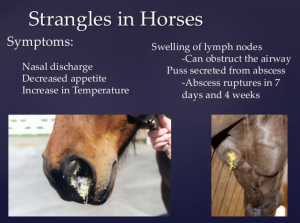February 2017 – There are confirmed reports of Strangles at barns in Monroe, Snohomish County and King County. The barns are under veterinarian supervision, self-quarantined, with the horses improving. In response to this recent outbreak several proactive barns have have placed a halt on arena/barn haul-ins and equine events are being rescheduled or cancelled.
Strangles, also know as equine distemper, is a highly contagious upper respiratory tract infection of horses caused by the bacterium Streptococcus equi. Streptococcus inhabits the respiratory tract of sick horses and carriers (those horses that might not presenting any symptoms). This disease spreads easily via the nasal secretions and when the jaw lymph nodes abscesses and drain pus. Horses can become infected through direct contact with diseased horses; contact with people, equipment, common water source, or surfaces that have been recently touched by diseased horses. In addition, carrier horses that appear healthy can shed bacteria trapped in their guttural pouches, typically through a shared water source.
Practicing smart bio-security goes a long ways in preventing a Strangles outbreak.
- Have a separate three to four week quarantine area for new arrivals.
- Use of the inter-nasal Strangles vaccine has been shown to be 70-80% effective. When it does not prevent the disease, it does limit the severity clinical symptoms. There are specific guidelines for use of this vaccine, discus with your veterinarian. A horse that has had Strangles will have some immunity to a reinfection. Tests show this may last anywhere from six months to several years. If they are re-exposed to Strangles they are more likely to respond like a vaccinated horse and may show mild to no clinical signs.
- Use of separate water sources, keep end of hose out of water sources to limit potential cross contamination. Provide clean water and regularly disinfect buckets, troughs, and hose ends. Note: the S. equi bacteria can survive for three to four weeks in water. Three days in soil, seven days on a fence post, and if discharge/pus is frozen can persist to infect when thawed.
- At events, leave your horse by your trailer, disinfect stalls and perimeter, do not allow them to nuzzle facility rails or any potentially contagious surface.
- Use your quarantine area for horses returning from events.
- Monitor temperature preferably twice daily as a spike in fever can be an indicator.
- Discourage visitors from touching horses.
What are signs of Strangles?
- The incubation period is about 3-6 days, but can vary from 2-15 days.
- Infected horses typically became sick quite rapidly with a high temperature, listless, and may have a slight cough.
- Their upper respiratory tract becomes inflamed, making swallowing painful, typically they will have loss of appetite and sometimes extend their the head and neck to ease discomfort.
- A watery discharge from the nose is followed by a copious, yellow pus-like discharge.
- About 10-14 days typically but not always the lymph nodes around the jaw, head, and neck swell, become abscessed and then rupture with large quantities of creamy, yellow pus. Inflammation of the guttural pouch or sinuses may occur.
Continue to educate yourself about Strangles; both in prevention, how to manage an outbreak, and understanding how carrier horses contribute to outbreaks. This disease is highly contagious and can be easily “unintentionally” spread. Talk to your veterinarian about recommended additional testing, including accessing the guttural pouch.
An important and typically not discussed component of Strangles is the carrier horse. Carrier horses, those infected with S. equi bacteria while not displaying any symptoms themselves can continue to infect other horses. It is important to determine which horses are carriers and which are not. And which horses may have come in contact with the bacteria and are now immune but have become carriers. Talk to your veterinarian about available testing for potential carrier horses.
Our equine community must fight the fiction surrounding Strangles with facts. Being educated with current information, using smart bio-security practices, consulting with your veterinarian regarding vaccination and testing all exposed horses in an outbreak to confirm the disease is gone will greatly reduce the number of future outbreaks in the Northwest.
Additional reading resources.
Strangles: Identification of carriers of Streptococcus equi.
Strangles: A Contagious Equine Disease
Strangles: New Millennium, Same Disease
Understanding Equine Strangles


